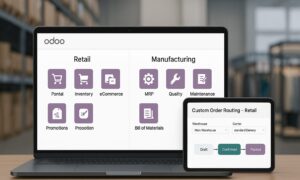Welcome to the fascinating world of green retailing! Have you ever wondered how those fresh, organic apples end up in your local grocery store or how that cozy, sustainable sweater makes its way onto the shelves? The answer lies within the intricate web known as the supply chain. In this blog post, we will unravel the mysteries behind “From Farm to Store: Understanding the Supply Chain in Green Retailing.” Join us on this journey as we explore every step of this eco-friendly process and discover how it contributes to a more sustainable and ethical shopping experience.
Introduction
Green retailing is a concept that has gained significant attention in recent years as consumers become more conscious of the environmental impact of their purchasing habits. It refers to the process of implementing sustainable and eco-friendly practices throughout the entire supply chain of retail products, from production to consumption.
The importance of green retail lies in its potential to minimize negative impacts on the environment while still meeting consumer demands. As the world’s population continues to grow, so does our consumption, leading to increased waste generation, pollution, and the depletion of natural resources. Therefore, it is imperative for retailers and businesses to adopt more sustainable practices in order to mitigate these harmful effects.
One of the primary objectives of green retailing is to reduce carbon footprints by minimizing energy consumption and greenhouse gas emissions throughout the supply chain. This can be achieved through various initiatives, such as using renewable energy sources, optimizing transportation routes, investing in energy-efficient technologies, and promoting recycling.
Explaining the Supply Chain in Green Retailing
Green retailing is a growing trend in the retail industry, with consumers becoming more conscious of the environmental impact of their purchases. From organic foods to sustainable clothing, customers are actively seeking out products that align with their values of sustainability and ethical production. However, understanding how these products make it from farm to store can be complex.
This is where the supply chain comes into play. The supply chain refers to the interconnected network of businesses and organizations involved in producing and distributing a product or service. In green retailing, this includes everything from sourcing raw materials sustainably to delivering the final product to the customer in an environmentally friendly manner.
The first step in understanding the supply chain in green retailing is identifying what goes into making a product “green.” This could include using organic or sustainably sourced materials, implementing fair labor practices, reducing carbon emissions during production and transportation, and ensuring ethical treatment of workers throughout the entire supply chain.
From Farm to Store: The Process
The process of getting products from the farm to the store involves multiple steps and stakeholders. It is known as the supply chain, and it plays a crucial role in green retailing. Understanding this process is essential for both retailers and consumers who are looking to make more sustainable choices.
1. Sourcing Sustainable Materials: The first step in the supply chain is sourcing raw materials from farms that use sustainable practices. This includes using organic farming methods, limiting chemical inputs, and promoting biodiversity on their land. By choosing these materials, retailers can support environmentally responsible farming practices.
2. Transportation: Once the raw materials are sourced, they need to be transported to manufacturing facilities where they will be processed into finished products. This transportation process can have a significant impact on the environment due to carbon emissions from trucks, planes, or ships. To reduce this impact, retailers can choose suppliers that are closer geographically or use alternative modes of transportation such as rail or waterways.
3. Manufacturing: In this stage, raw materials are transformed into finished products through various processes such as cutting, sewing, or packaging. Green retailing requires manufacturers to use eco-friendly production methods that minimize waste and reduce energy consumption.
4. Packaging: Packaging plays a vital role in preserving and protecting products during transportation and on store shelves. However, traditional packaging materials like plastic can have harmful effects on the environment if not disposed of properly. Retailers have started adopting more sustainable packaging options, such as biodegradable materials or minimal packaging, to reduce waste.
Benefits of Sustainable Supply Chains in Green Retailing
Sustainable supply chains have become a key aspect of green retailing, as consumers are becoming increasingly environmentally conscious and demanding more eco-friendly products. These supply chains focus on reducing the environmental impact of the entire production process, from farm to store. In this section, we will discuss the numerous benefits that come with implementing sustainable supply chains in green retailing.
1. Reduced carbon footprint:
One of the most significant advantages of sustainable supply chains is the reduction of their carbon footprint. This is achieved by implementing energy-efficient practices at each stage of the supply chain, such as using renewable energy sources for transportation and adopting sustainable packaging materials. By reducing greenhouse gas emissions throughout the supply chain, retailers can help mitigate climate change and contribute towards a cleaner environment.
2. Cost Savings:
Implementing sustainable practices in the supply chain can also result in cost savings for retailers. This is because sustainable methods often lead to reduced resource consumption, such as water and energy, which can translate into lower operational costs. Additionally, many consumers are willing to pay a premium for environmentally friendly products, providing an opportunity for retailers to increase their profit margins.
3. Improved Reputation:
In today’s socially connected world, businesses are under increasing pressure to demonstrate their commitment to sustainability and environmental responsibility. By incorporating sustainable practices into their supply chain processes, retailers can enhance their reputation among consumers who prioritize sustainability. A positive reputation can lead to increased customer loyalty and attract new customers who align with your brand values.
Key Players in the Green Retailing Supply Chain
The green retail supply chain involves a complex network of players, each playing a crucial role in ensuring that environmentally friendly products make their way from the farm to the store. In this section, we will delve deeper into the key players in this supply chain and explore how they contribute to promoting sustainability in the retail industry.
1. Farmers and Suppliers:
At the beginning of the green retail supply chain, we have farmers who are responsible for growing crops using sustainable practices. These include organic farming methods, the use of renewable energy, and minimizing water consumption. They work closely with suppliers who provide them with seeds, fertilizers, and other resources needed for farming. Together, they play a crucial role in producing high-quality, sustainable products.
2. Manufacturers:
Manufacturers are responsible for turning raw materials into finished goods that can be sold in stores. In green retailing, manufacturers focus on using eco-friendly production processes such as recycling materials and reducing carbon emissions. They also ensure that their packaging is recyclable or biodegradable to minimize waste.
3. Distributors:
Distributors act as intermediaries between manufacturers and retailers by transporting products from factories to warehouses or directly to retailers’ stores. In green retailing, distributors must adhere to strict environmental standards when it comes to transportation methods and packaging materials used.
4. Retailers:
Retailers are at the forefront of green retailing as they sell sustainable products directly to consumers. They have an important role in educating consumers about environmentally friendly options and promoting eco-friendly lifestyles. Retailers also have the power to influence manufacturers and suppliers to adopt sustainable practices in their production processes.
5. Consumers:
Consumers are a crucial part of the green retail supply chain, as they ultimately drive demand for sustainable products. Their purchasing decisions can have a significant impact on the entire supply chain, influencing farmers, manufacturers, distributors, and retailers to produce more environmentally friendly products.
Challenges Faced by the Green Supply Chain
Green retailing, also known as sustainable or eco-friendly retailing, has gained significant popularity in recent years due to the growing consumer demand for environmentally friendly products. However, this shift towards sustainability in the retail industry comes with its own set of challenges. In this section, we will discuss some of the key challenges faced by the green supply chain.
1. Sourcing Sustainable Materials:
One of the biggest challenges for green retailers is sourcing sustainable materials for their products. This involves finding suppliers who use ethical and environmentally responsible practices to produce raw materials such as organic cotton, bamboo, or recycled plastic. The limited availability and high cost of these materials can make it difficult for retailers to maintain a consistent supply chain while keeping their prices competitive.
2. Transportation and Logistics:
Transportation is an essential part of any supply chain process, but it also has a significant environmental impact. Green retailers face challenges in finding transportation methods that align with their sustainability goals. Traditional modes of transportation, such as air freight or trucking, emit high levels of carbon emissions, which goes against the ethos of green retailing. Finding alternative modes, such as rail or electric vehicles, can be costly and require extensive planning.
3. Packaging:
Packaging is another significant challenge for green retailers, as most traditional packaging materials are non-biodegradable and harmful to the environment. Green packaging options like biodegradable plastics or paper-based alternatives can be expensive and may not always offer adequate protection during transportation and storage.
Conclusion
Green retailing has become a popular trend in the retail industry, with consumers becoming increasingly aware and concerned about the environmental impact of their purchasing habits. As a result, retailers have started to incorporate sustainable practices into their supply chain management in order to meet these consumer demands.



































